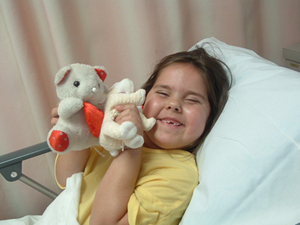Diagnosing Brain Tumors
The prognosis (in other words, the chance of survival) for children with brain tumors varies depending on a number of factors, including:
- The type of tumor, as determined by the pathologist
- The area of the brain involved
- The ability to surgically remove the tumor partially or completely
- The growth rate of the tumor
- The age of the child at the time of diagnosis
Expand all sections Close all sections
Imaging Tests
The development of advanced imaging equipment and techniques has provided an important breakthrough in the diagnosis and treatment of brain tumors. Standard tests used to diagnose these tumors include:
Both of these tests provide clear pictures of the brain or spinal cord. They assist physicians in identifying the precise location of the tumor. Additional tests often performed during the diagnostic work-up of brain tumors, including:
- Positron Emission Tomography (PET) scan, similar to CT and MRI, but assesses the metabolic activity of the tumor
- SPECT scan, similar to an MRI but measures the uptake of certain substances in the brain; a SPECT scan is also helpful in differentiating normal brain, tumor and scar tissue following surgery
- Electroencephalogram (EEG), used to evaluate seizure activity
Other Tests
In most cases, surgery will be performed once doctors have precisely defined the location of the tumor. The purpose of surgery is to obtain a portion of the tumor for the pathologist to examine carefully under the microscope. This allows doctors to make the correct diagnosis and to plan treatment. During surgery, the surgeon will attempt to remove as much of the tumor as possible without damaging any normal adjacent brain tissue.
After the specific diagnosis is established, a variety of other tests may be necessary to determine whether the tumor has spread to any other organs in the body. Further testing will also help to evaluate the function of other body systems prior to starting any subsequent therapy. Such tests may include:
- Lumbar puncture (spinal tap) to evaluate spinal fluid for tumor cells
- Audiogram (hearing test)
- Blood tests of liver and kidney function, salt balance and hormone function
- Neuropsychological evaluation
Causes of Brain Tumors
We currently do not know what causes brain tumors. Only a few risk factors for brain tumors are known for sure:
Expand all sections Close all sections
Genetic conditions
Children with some genetic syndromes are more likely to develop brain tumors than other children. The syndromes are neurofibromatosis, Tuberous sclerosis, von Hippel-Lindau disease, Li-Fraumeni syndrome, ataxia telangiectasia, basal cell nevus syndrome (Gorlin syndrome) and hereditary non-polyposis colon cancer (Turcotsyndrome). Children with these genetic conditions are more at risk for brain tumors, but these account for only a small fraction of cases. These syndromes are usually recognized early in childhood, so it is most likely that you would know if your child has one of these conditions.
Prior Radiation
Children who have received radiation therapy to the head as part of treatment for an earlier cancer are at an increased risk for a new brain tumor.
Male/Female
The patterns differ depending on the type of brain tumor. Boys and girls are equally likely to develop an astrocytoma. Boys are more likely to develop a medulloblastoma, ependymoma or germ cell tumor than girls.
Race and Ethnicity
Caucasian children are more likely than African American children to develop a medulloblastoma or ependymoma. Other types of brain tumors affect Caucasian and African American children equally. Differences in other ethnic groups have not yet been identified.

